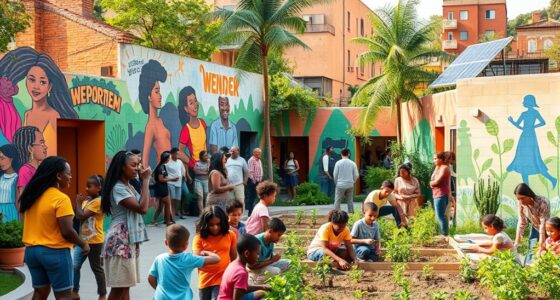Community co-design means working directly with residents and stakeholders to develop solutions that truly fit your local needs. When you involve people early and often, you tap into diverse insights, build trust, and create shared ownership of projects. This collaborative approach guarantees initiatives are more effective, sustainable, and embraced by the community. If you want to understand how shaping solutions together can make a lasting impact, there’s more to discover ahead.
Key Takeaways
- Engages residents and stakeholders early to ensure solutions reflect community needs and priorities.
- Incorporates diverse perspectives to foster innovative and culturally relevant approaches.
- Creates transparent spaces for dialogue, building trust and shared ownership of initiatives.
- Empowers community members to contribute insights, enhancing the sustainability of outcomes.
- Uses clear communication and visual tools to facilitate understanding and active participation.

Have you ever wondered how communities can create solutions that truly meet their needs? The key lies in participatory planning, a process that actively involves residents, local organizations, and other stakeholders in shaping the projects and policies that affect their lives. Instead of top-down decisions made by a few officials, participatory planning empowers community members to share their insights, concerns, and ideas from the very beginning. This approach guarantees that solutions are tailored to the unique context of the community, increasing the likelihood of success and long-term sustainability.
Engaging stakeholders is at the heart of community co-design. When you involve diverse voices—whether they’re residents, business owners, youth, or service providers—you tap into a wide range of experiences and perspectives. This inclusiveness leads to more innovative and relevant solutions, because it considers different needs and priorities. Effective stakeholder engagement also builds trust and a sense of ownership among community members, making them more committed to implementing and maintaining the initiatives. It’s not just about gathering input; it’s about fostering genuine collaboration where everyone feels heard and valued.
To make participatory planning work, you need to create spaces where dialogue can flourish. This might be through town hall meetings, focus groups, or online platforms that facilitate ongoing communication. When people see that their contributions matter and influence the final outcome, they become more invested in the process. As a participant, your role is vital—you bring your lived experience, insights, and ideas, helping shape solutions that resonate with the community’s reality. When community members are involved early and consistently, the planning process becomes more transparent and democratic, reducing the risk of solutions that are out of touch with local needs. Additionally, incorporating color accuracy and contrast ratios from home cinema technology can serve as an analogy for how visual and perceptual clarity enhances overall understanding and engagement in collaborative efforts.
Frequently Asked Questions
How Do You Measure the Success of Community Co-Design Projects?
You measure the success of community co-design projects by gathering participant feedback to understand their experience and satisfaction. Additionally, you assess the project impact by evaluating tangible outcomes, such as improved community well-being or increased engagement. When participants feel heard and see meaningful changes, it indicates the project’s success. Continuous monitoring and adjusting based on feedback help guarantee lasting, positive results for the community.
What Are Common Challenges Faced During Community Co-Design Initiatives?
Like steering a stormy sea, community co-design faces common challenges such as stakeholder conflicts and resource limitations. You might find disagreements among participants or struggle to secure enough funding and time. These hurdles can slow progress, but with patience and clear communication, you can steer through them. Addressing conflicts early and leveraging community strengths helps transform obstacles into opportunities for lasting, meaningful solutions.
How Can Skeptics Be Convinced to Participate in Co-Design Processes?
To convince skeptics to participate, focus on trust building by openly sharing the process and listening to their concerns. Use incentive strategies like highlighting tangible benefits and involving them in decision-making. Show respect for their perspectives, and demonstrate how their input impacts real change. When they see their voice matters and trust is established, skeptics become more willing to engage actively in co-design efforts.
What Funding Options Are Available for Community Co-Design Projects?
You can explore grant opportunities, seek crowdfunding options, and pursue local sponsorships to fund community co-design projects. These options provide diverse financial resources, foster community engagement, and guarantee sustainability. Grants offer structured funding, crowdfunding mobilizes public support, and sponsorships build partnerships. By combining these avenues, you maximize your chances of securing the necessary funds, empowering your project, and creating lasting, community-driven solutions.
How Do You Ensure Long-Term Community Engagement and Sustainability?
To guarantee long-term community engagement and sustainability, you foster community ownership by involving residents from the start and respecting their input. Keep ongoing participation by creating regular opportunities for feedback and collaboration, demonstrating that their voices matter. Build trust through transparency and shared decision-making, which encourages continued involvement. When the community feels a sense of ownership, they’re more likely to stay engaged and support lasting solutions.
Conclusion
By actively partnering with your community, you become the gardener nurturing a vibrant, resilient landscape. When everyone’s ideas and efforts intertwine, lasting solutions bloom from a shared foundation. Remember, co-design isn’t just planting seeds; it’s tending a garden together, watching it grow stronger with each collaborative effort. Embrace this approach, and you’ll see your community flourish into a thriving, enduring masterpiece built by all of you.








